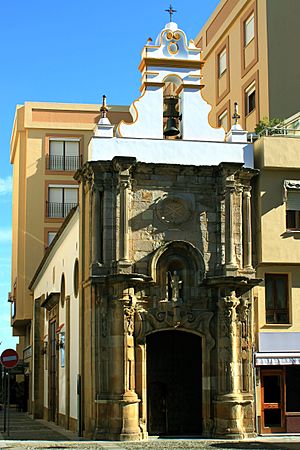Chapel of Our Lady of Europe facts for kids
Quick facts for kids Chapel of Our Lady of EuropeCapilla de Nuestra Señora de Europa |
|
|---|---|
|
previously: Chapel of St. Bernard (Spanish: Capilla de San Bernardo)
|
|

Façade of the chapel
|
|
| Religion | |
| Affiliation | Roman Catholic |
| Province | Diocese of Cádiz and Ceuta |
| Ecclesiastical or organizational status | Chapel |
| Leadership | Bishop Rafael Zornoza Boy |
| Year consecrated | 1690 (St. Bernard) 1704 (Our Lady of Europe) |
| Location | |
| Location | Plaza Alta, Algeciras, Spain |
| Architecture | |
| Architect(s) | Torcuato Cayón |
| Architectural style | Baroque |
| Founder | Gálvez family |
| Groundbreaking | 1695 |
| Completed | 1769 |
| Official name: Capilla de Nuestra Señora de Europa | |
| Type | Non-movable |
| Criteria | Monument |
| Designated | 1981 |
| Reference no. | RI-51-0004487 |
The Chapel of Our Lady of Europe (which in Spanish is called Capilla de Nuestra Señora de Europa) is a special Roman Catholic chapel. You can find it in the main square, called Plaza Alta, in the city of Algeciras, Spain. People often call it the "Capillita de Europa" or "Small Chapel of Europe."
This little chapel is very important because it helped start the modern city of Algeciras. For many years, from 1704 to 1864, it was home to a famous statue. This statue was of the Virgin Mary and the Child Jesus. It had been kept in the Shrine of Our Lady of Europe in Gibraltar before it was moved here.
Contents
History of the Chapel
The chapel you see today was finished in 1769. The first building was badly damaged by a big earthquake in Lisbon in 1755. Because of the damage, the original chapel had to be taken down.
The very first chapel was built in 1690. It was dedicated to Saint Bernard, who is a patron saint of Gibraltar. This first chapel was on the farm of the wealthy Gálvez family. The bishop of Cádiz gave permission for it to be built. In 1981, the chapel was officially recognized as a "Property of Cultural Interest." This means it's a very important historical building.
How Algeciras Grew Around the Chapel
In 1704, a fleet from England and the Netherlands took control of Gibraltar. Most people living in Gibraltar left their homes. Some of these people built new houses near the Chapel of St. Bernard.
They thought these new homes would only be temporary. They hoped Gibraltar would be returned to Spain soon. But as time passed, this temporary settlement grew into a new town. This is how the modern city of Algeciras began, after it had been destroyed in 1379.
The Journey of the Statue
The chapel became a safe place for the statue of Our Lady of Europe. This statue of the Virgin Mary and Child was greatly respected in Gibraltar. It was kept in the Shrine of Our Lady of Europe.
When Gibraltar was taken, the shrine was looted. The statue was broken into pieces and thrown into the sea. Luckily, the statue was made of wood. A fisherman found the pieces floating in the Bay of Gibraltar. He gave them to Juan Romero de Figueroa, a priest from Gibraltar.
Father Romero de Figueroa stayed in Gibraltar for a while. Later, he took the pieces of the statue to Algeciras for safekeeping. The old Chapel of St. Bernard then became dedicated to Our Lady of Europe. It was renamed the Chapel of Our Lady of Europe. The original statue was finally returned to Gibraltar in 1864.
Chapel Design and Features
The chapel was designed by an architect named Torcuato Cayón. Inside, it has a single curved ceiling and a dome at the top. The dome is supported by special curved triangles called pendentives.
The dome is divided into eight sections. In these sections and on the pendentives, there are paintings or sculptures of the Apostles.
Outside the Chapel
The front of the chapel, called the façade, has two main parts and a bell tower. Above the main door, there is a small space with a statue of Saint Bernard. This statue was placed there more recently.
The chapel faced some tough times. In 1931, it was robbed. Then, in 1936, it was sold by the church to a private person. In the 1940s, it was left empty and used as a storage space for a mechanic's workshop.
However, in 1943, the city hall restored it. Later, in 1989, it needed another restoration. This was because a building next to it on the left side had been destroyed.
Today, the chapel is home to a religious group called the Brotherhood of the Cristo Atado a la Columna. They have a statue of Christ Tied to the Column, made by José Román Corzanego. They also have a statue of Holy Mary of the Tears, made in Seville.
See also
 In Spanish: Capilla de Nuestra Señora de Europa para niños
In Spanish: Capilla de Nuestra Señora de Europa para niños

